AMD ATI Radeon HD 5970 Review
AMD ATI Radeon HD 5970
With two GPUs on one card, AMD's new range-topping graphics card takes performance to another level.
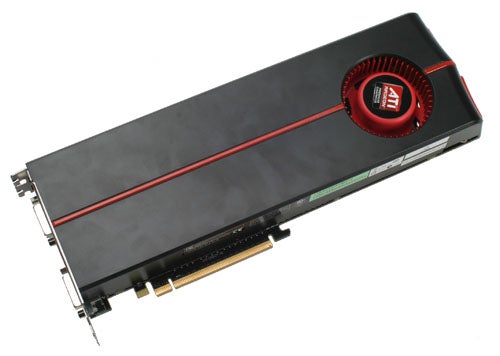
Verdict
Key Specifications
- Review Price: £519.98
Today sees the launch of AMD’s latest top-of-the-range DirectX 11 graphics card, the ATI Radeon HD 5970 (codenamed Hemlock). Like AMD’s previous high-end cards, it uses two graphics chips housed on a single board and has an internal CrossFire interface to get the ultimate in performance. Since AMD’s current top-of-the-range single-chip card, the Radeon HD 5870, is already one of the fastest in the world, this new card is sure to take performance to the next level. Shortly we’ll see if it does but first, a bit of a history lesson. 
For the last few generations of its graphics cards, AMD’s strategy has been to create a chip that will compete at what it sees as the more lucrative mid- to high-end market of £200-£300, rather than the ultra high-end of £400+. It then uses two of the chips to create a single monster of a card to compete at that top-end. The same architecture is then used to design scaled down versions of the chip to create lower end cards. In contrast, nVidia has aimed its previous top-end chips much higher, thus creating much more expensive and faster single chip cards. This is still nVidia’s strategy, as its latest ‘Fermi’ architecture proves.
The result of this is that AMD has ”had” to bring its dual-chip cards to market simply to compete with nVidia’s top-end single chip cards (not to mention nVidia’s dual-chip cards as well). However, this time around we have a slightly different situation. While the HD 5870 still isn’t the out and out fastest card – the nVidia GeForce GTX 295 and ATI Radeon HD 4870 X2 (both dual-chip cards) still trade places for top spot with it – it’s the clear choice of the three due to its support of DirectX 11, its lower power consumption, and better compatibility thanks to its single chip (while CrossFire/SLI support is getting ever better, some games still have issues with these dual-chip solutions). As such, the need for AMD to release the HD 5970 is limited right now; it could easily sit back and wait for the HD 5870 to reap its rewards for a bit longer. Nevertheless, AMD ”has” chosen to launch the card already so let’s take a closer look. 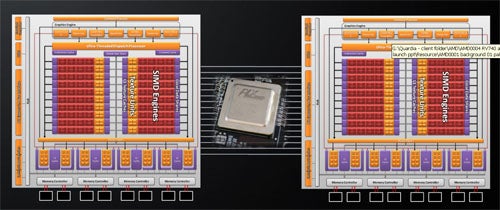
The HD 5970 uses two Cypress chips mounted on a single board with 1GB of GDDR5 memory for each chip. The GPUs run at 725MHz while the memory is clocked at 1GHz (effectively 4GHz), which theoretically means this card will have performance that sits somewhere between two HD 5870s in Crossfire and two HD 5850s also in CrossFire – it has the same number of SIMDs as the 5870 but the clock speed of the 5850. 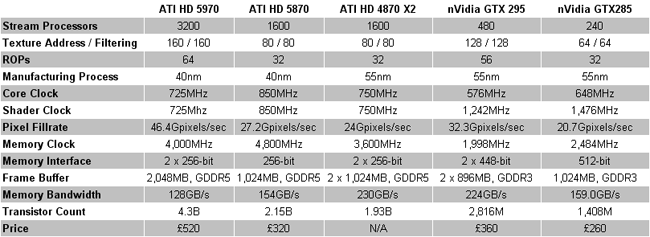
Physically the card is something to behold, at 12.2in (310mm) long and weighing 1.2kg, it is simply colossal. This immense length means the card overhangs the back of a standard ATX motherboard by 2.5in (6.5cm) and as such won’t fit in many cases, so check there’s space before opting for this card (incidentally, the ATX specification does allow for cards up to 13.3in long so AMD isn’t breaking any rules here). 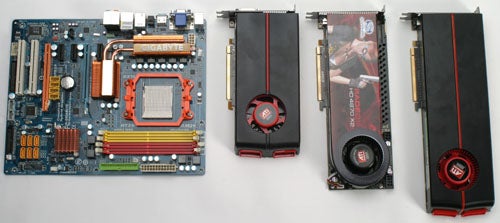
Conversely, by picking prime examples of its Cypress chips and keeping the clock speeds down, AMD has managed to keep the HD 5970’s total power consumption to below 300W, so it only requires an 8-pin and a 6-pin auxiliary power connector, rather than two 8-pin connectors. This means it stands a better chance of being compatible with your power supply.
Despite the decent power consumption claims, AMD was at pains to point out that the HD 5970 has plenty of headroom for overclocking. As well as the chips themselves already being ‘underclocked’, the scope for boosting performance is aided by particularly high quality power management circuitry and the new cooler that AMD has employed. The latter uses a vapour chamber (essentially a flat heatpipe) to contact directly with the chips, with a conventional aluminium fin arrangement on top of this to dissipate the heat. This vapour chamber, and the rest of the cooling system, can actually cope with up to 400W of thermal dissipation. 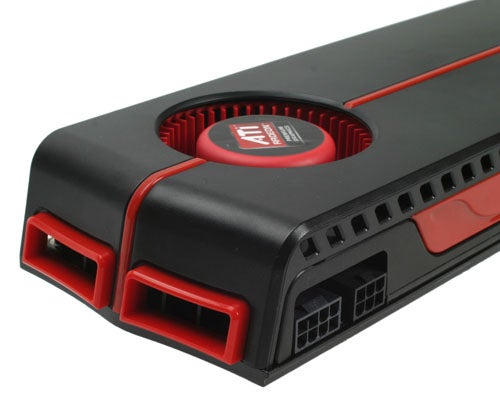
AMD also pointed out that OEMs will have the option to use two 8-pin power connectors and significantly overclock its cards to sell at a premium. It will be some time before such cards arrive though. 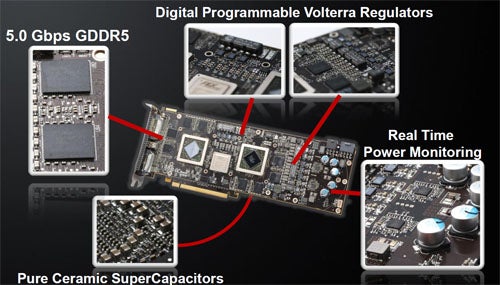
As a consequence of the new cooling system, AMD has had to change its output configuration from the ‘two dual-link DVIs, DisplayPort (DP), and HDMI’ configuration we’ve seen on all previous 5000 series cards. Instead, one full slot of the output panel is given up to exhausting the card’s heat and the other slot is home to two dual-link DVI ports and a mini-DP. Before getting too upset, though, remember that you could only use three of the four outputs at any one time on the other cards anyway. Furthermore, with DVI to HDMI and mini-DP to full-size-DP converters in the box, you’ll still have all the various output configurations available in some form or other. The DVI/HDMI also supports digital audio output over HDMI like all previous AMD cards.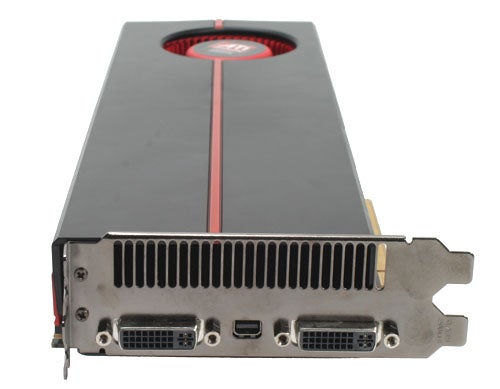
A first for this card is that it will support AMD’s new Eyefinity multi-display technology, something that previous CrossFire setups couldn’t do. This means you’ll be able to game on three monitors at once with a total resolution of up to 7,680 x 1,600. Currently just 22 games are supported but this will of course increase over time. Meanwhile Eyefinity support will find its way to conventional Crossfire setups at the start of next year. 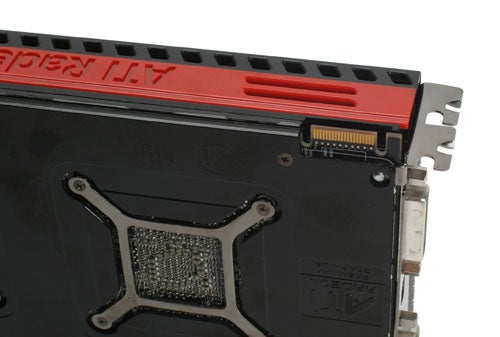
So, that’s how the card stacks up physically and in terms of features but the real question as always is how does it perform? Read on to find out.
We tested this card on our usual test bench, the details of which are below. We ran five games to test for performance then checked total system power consumption and noise levels both when idling and gaming. As always we ran our tests multiple times to try and ensure consistent figures then record the average.
With the exception of Counter-Strike: Source (CSS) and Crysis, the gaming results are recorded manually using FRAPs while we repeatedly play the same section of the game. For CSS and Crysis we use timedemos and framerate recording is automated. For Crysis, all in-game detail settings are set to High while all the other games are run at their highest possible graphical settings.
Meanwhile, power draw testing is done using a mains inline power meter. The idle figure is taken when the system is simply on the Windows Desktop with no obvious background activity going on. The load test is then taken when running our Crysis timedemo at 1,920 x 1,200 with 2xAA. Likewise, noise levels are tested using the same idle and load scenarios as above. We isolate the test bed in a sound-proof box and record noise levels from about 30cm away.
We find that below about 40dB is indicative of a card that when housed in a conventional case will go unnoticed in a relatively quiet home office environment. For use in a ‘silent’ PC (for in the bedroom or cinema room) without resorting to sound-proofing your case, you’ll want a card that’s lower than 35dB at idle. As for under load, above about 50dB is a constantly noticeable level that would disturb you if using speakers or open-back headphones while gaming. 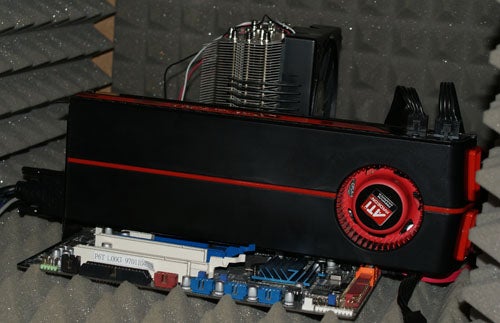
”’Test System”’
* Intel Core i7 965 Extreme Edition
* Asus P6T motherboard
* 3 x 1GB Qimonda IMSH1GU03A1F1C-10F PC3-8500 DDR3 RAM
* 150GB Western Digital Raptor
* Microsoft Windows Vista Home Premium 64-bit
”’Cards Tested”’
* AMD ATI HD 5970
* AMD ATI HD 5870
* AMD ATI HD 4870 X2
* nVidia GeForce GTX 295
* nVidia GeForce GTX 285
”’Drivers”’
* AMD HD 5970 – Hemlock beta driver 8.663.1
* Other AMD ATI HD 5000 series – 5000 driver
* Other ATI cards – Catalyst 9.9
* nVidia cards – 190.02
”’Games Tested”’
* Far Cry 2
* Crysis
* Race Driver: GRID
* Call of Duty 4
* Counter-Strike: Source
Looking first at Far Cry 2, the HD 5970 starts with a healthy lead over the competition and maintains it throughout, pulling further and further ahead until, at 2,560 x 1,600 with 4xAA, it has nearly a 50 per cent lead over its nearest rival, the GTX 295. Of course, the thing to note here is that it’s only at this sort of resolution that all the other cards on test don’t deliver very playable framerates, so unless you have a monitor with such a resolution this card is going to be overkill.
It’s a very similar picture in Crysis, though rather than the HD 4870 X2 being the most consistent nearest rival, it is now the GTX 295. The performance advantage of the HD 5970 is also felt earlier on with most of the other cards struggling to deliver playable framerates at 1,920 x 1,200, 4xAA. The HD 5970 struggles a little at 2,560 x 1,600 but will still give just playable results. It also holds a significant 20 per cent advantage over its nearest rival at this resolution. 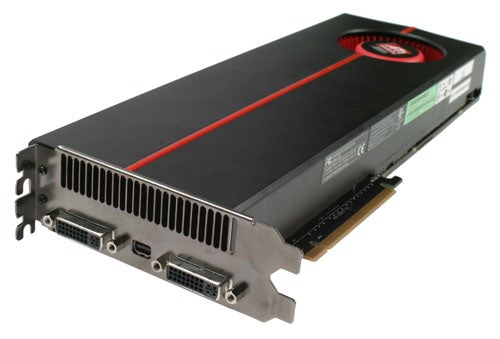
Moving onto less demanding games and we find ourselves in the situation where all cards on test deliver playable framerates even at 2,560 x 1,600, 4xAA. Still, with the HD5970 outperforming its nearest rival in Race Driver: GRID by some 42 per cent and by 43 per cent in Call Of Duty 4 when testing at 2,560 x 1,600 4xAA, this card is certainly proving to have astonishing levels of performance.
The final game we test is Counter-Strike: Source and because all these cards give such good performance, it’s actually the CPU/rest of the system that is holding performance back. As such we’ve only shown the 2,560 x 1,600 results. Here, most of the other cards begin to become the bottleneck and performance drops just a tad. However, the HD 5970 is still completely CPU-limited even at the highest setting, such is its processing power.
Looking now at power consumption and astonishingly, despite being such a fast card, the HD 5970 isn’t the most power hungry card on test. That said, the two cards that do beat it are the previous generation dual-chip cards, so that’s not surprising. Regardless, the total system power figures of 143W at idle and 330W under load aren’t in the realms of the ridiculous.
The HD 5970 also performed well in our noise tests, producing no more noise than its single-chip cousin, the HD 5870, and significantly less than either the GTX 295 or GTX 285 when idling. Under load it does get pretty loud, though, and is only outstripped by the HD 4870 X2, which is a particularly noisy card. Essentially, you’ll want to be wearing headphones or employing some serious sound-proofing when gaming with this card.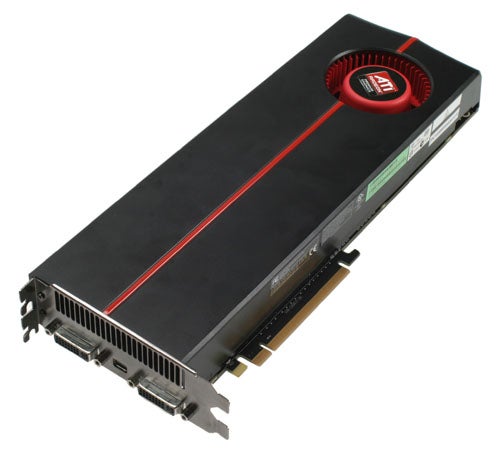
So, all told, the HD 5970 is an impressive card. It has absolutely bags of performance, has all the latest features, consumes a not horrific amount of power, and when idling it’s not too noisy either. However, there is one rather important factor yet to consider, price. Currently retailing for an eye-watering £519.98, this is the most expensive graphics card we’ve seen in years. As such, we find it impossible to recommend for anyone with a single monitor as the HD 5870 delivers enough performance in the majority of games and will save you £200.
However, taking into account Eyefinity, the HD 5970 starts to make sense. Even three relatively small monitors will give a total resolution exceeding that of a single 30-incher (2,560 x 1,600) so that extra performance will start to be of tangible benefit. And let’s face it, if you can afford to be buying three monitors just for a better gaming experience then spending £500 on a graphics card is something you’ll certainly consider.
”’Verdict”’
The AMD ATI Radeon HD 5970 is without doubt the single fastest graphics card on the planet. However, if you own a single monitor then it’s simply overkill and the HD 5870 is a much more sensible option. If you’re interested in pursuing a multi-monitor gaming setup, though, then this is a card well worth considering.
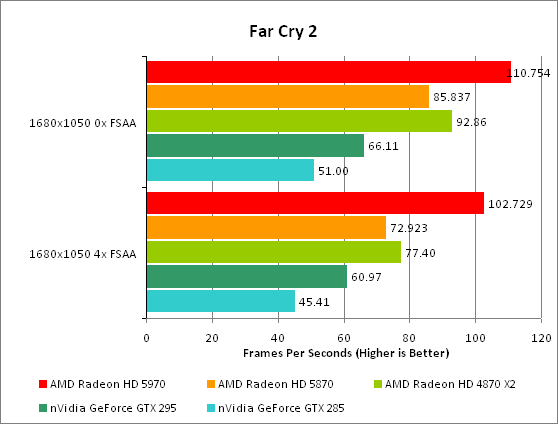
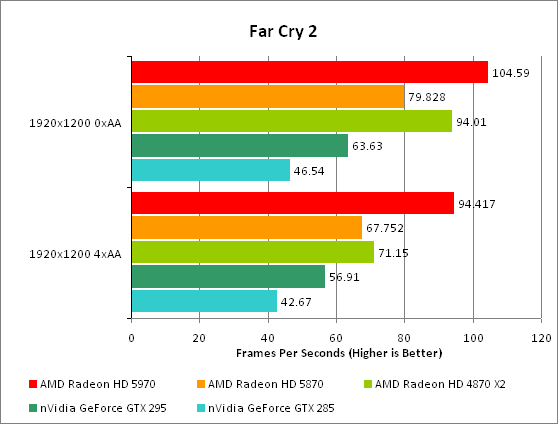
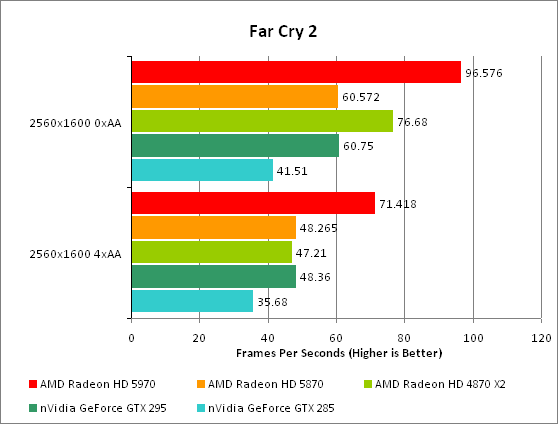
—-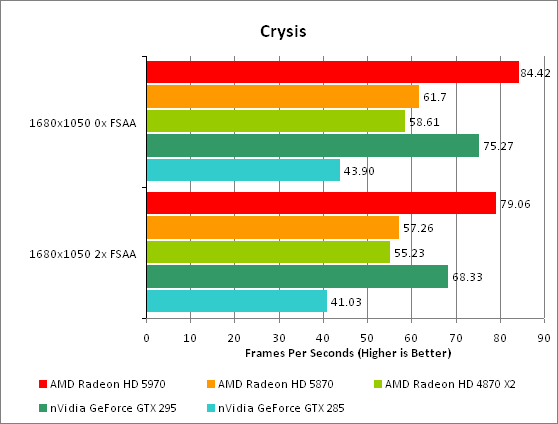
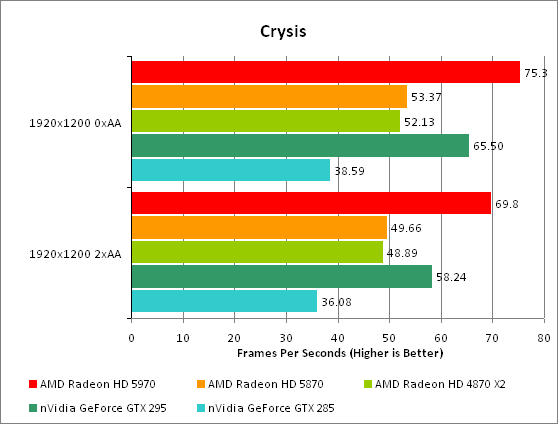
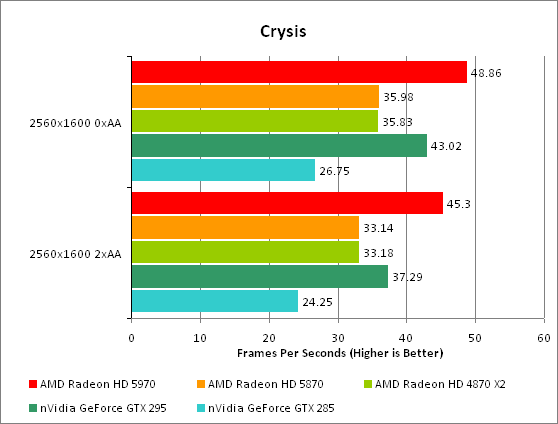
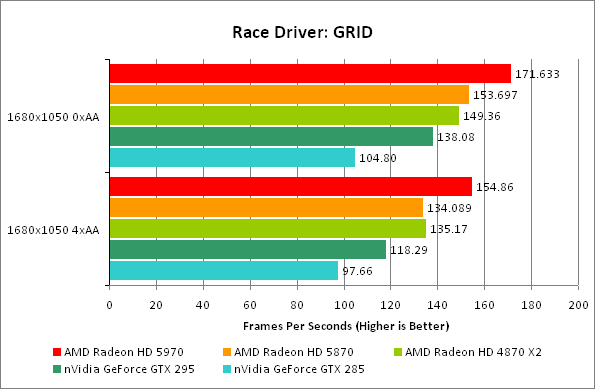
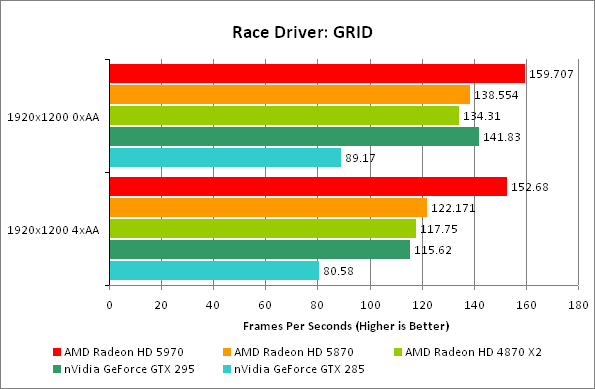
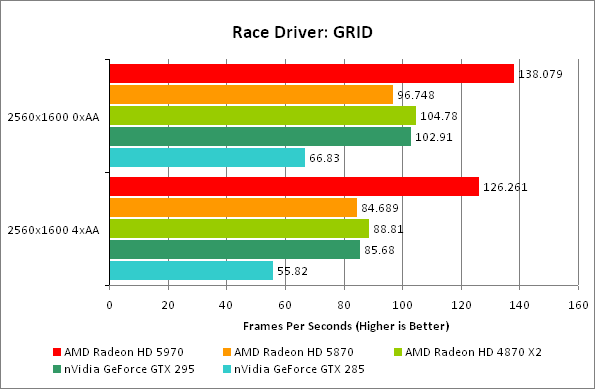
—-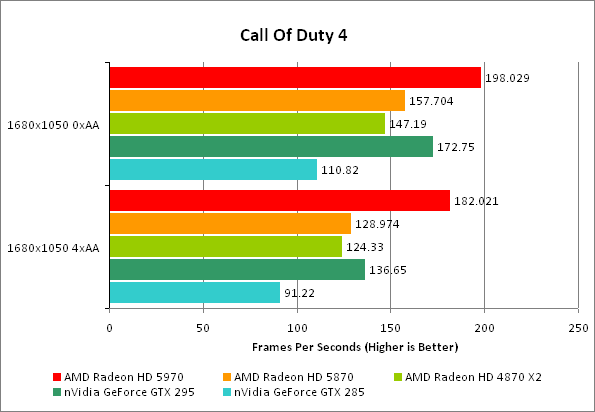
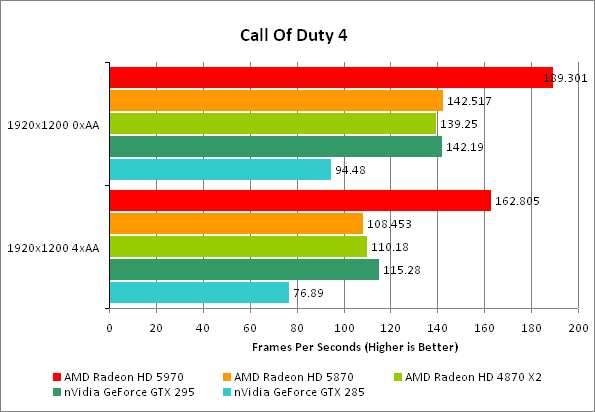
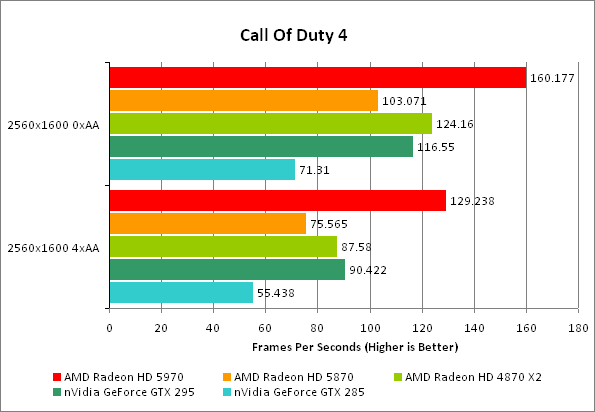
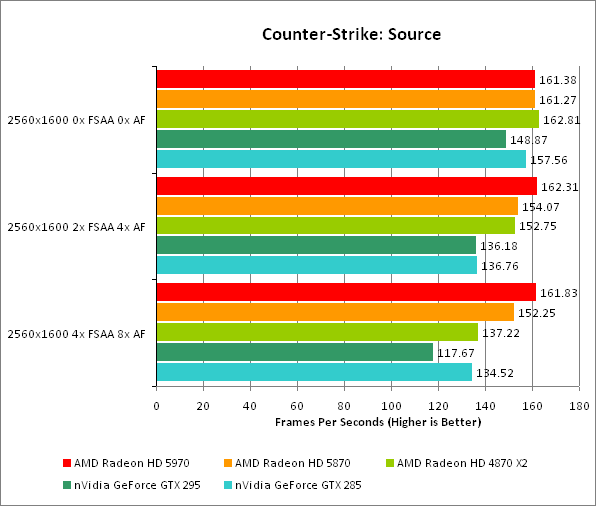
—-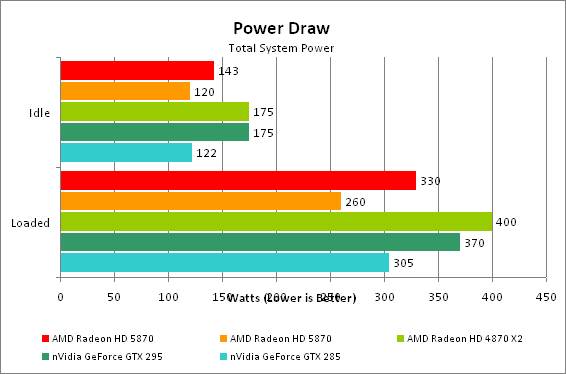
—-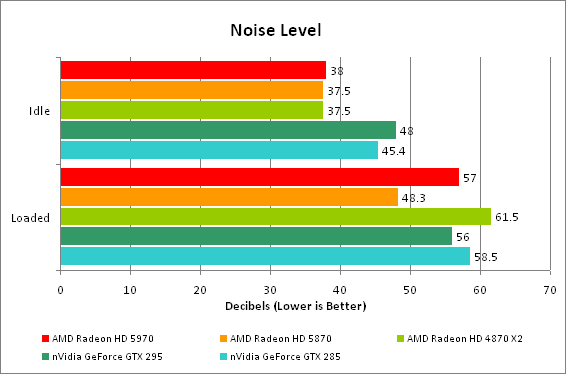
Trusted Score
Score in detail
-
Value 7
-
Features 10
-
Performance 10

